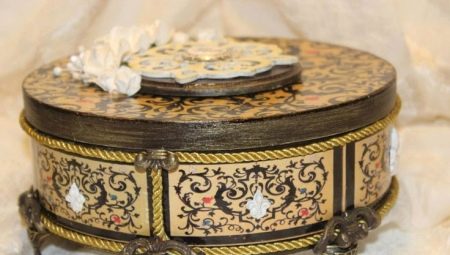The technique of decorating a wide variety of objects, gaining fame under the French name "decoupage", has become especially popular in the last decade. Children and adults are fond of decoupage, try different techniques, decorate trinkets and even massive furniture with their own hands. If you are also fascinated by the art of decoupage, you will be interested to learn more about the styles of this technique.
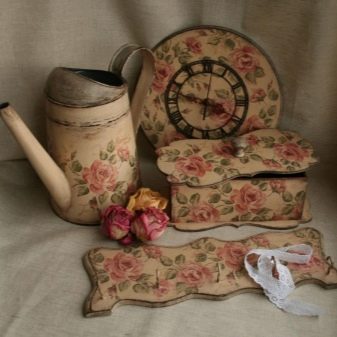

Provence
Beloved by tourists from all over the world, the province in the south of France gave the world of design, interior transformations, as well as various types of decorative art dozens (if not hundreds) of reasons for inspiration. Provencal style is a discreet, noble antiquity, which harmoniously combines with the elegance of French design.
Whitened surfaces and pastel shades are the main signs of Provence.
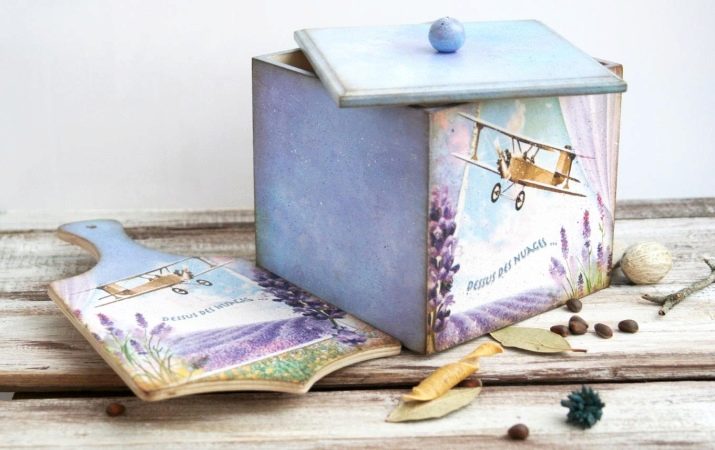
Almost all products made in this style have some fray, unevenness. It was as if the spirit of the time went through things, but did not make them old, a place which is only in a landfill, but, on the contrary, turned into a favorite retro. This artificial aging is also actively used in decoupage. Decoupage in the Provence style can be started with small things - decorating wooden combs, caskets, gradually picking up on the furniture.
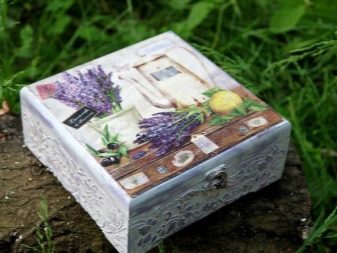
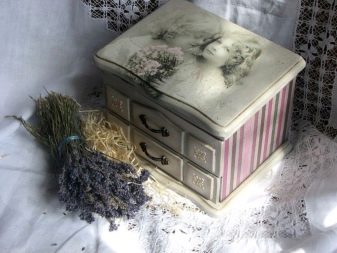
Shabby chic
The translation from English speaks for itself - shabby, battered, that’s what the word “shabby” means. Despite the unattractive name, it’s hard to find some other style, so gentle, reverent, beloved by aesthetes in many countries of the world. You can’t call the style old - only in the last quarter of the twentieth century this direction arose.
The following features are inherent in Shebby-chic style.
- Gentle tones. He does not like bright colors, everything is done in some kind of artificial ceiling. These things are like from the haze of years, literally shrouded in mystery, mystery, history.
- Slightly blurry drawings. Ancient images always lose their clarity (however, this is also characteristic of memories). Due to what we today think out their initial outlines, fantasize and slightly idealize the original image (and, in the case of memories, an event).
- Floral ornaments. Not one decoupage master class uses floral ornaments, but shabby chic exploits them very often. Small and large flowers can be seen on wallpaper, curtains, furniture surfaces, accessories. As if they had come down from retro-postcards, they cause nostalgia, sadness for what we did not find, but nevertheless these associations are pleasant to many - that's why decoupage napkins are often used to decorate things in the style of shabby chic.
- Angels, birds, palaces - Another top three motives for shabby chic. Along with English roses, strange birds in twisted cages and the outlines of beautiful palaces flaunt vintage artifacts.
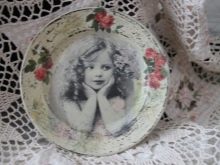
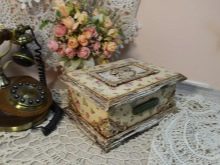
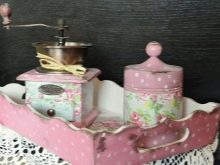
The atmosphere in this style is cozy, very delicate, delicate. There will be a pleasant bedroom, in which things are made in the style of shabby chic - the best place to relax, calm and privacy.
Simplicity
So called the style of a simple city. This is a democratic direction that does not abandon modern trends. Attracts novice decoupage lovers this style through the use of cheap materials. Newspapers and magazines (and modern ones) are the basis of the future decor.
If you are not a big fan of retrotematics, but decoupage is interesting for you as an art, try yourself in simplicity. The first work may be utilitarian. For example, decorate a cornflake plate. Torn edges and deliberate negligence are inherent in the style.
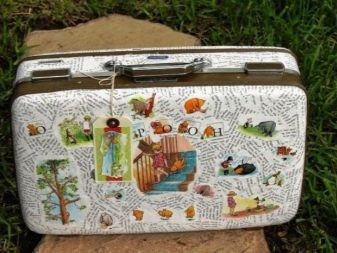
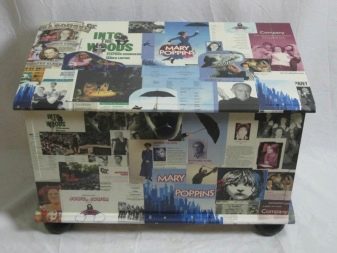
Victorian
Many decades have passed, and the aesthetics of the Victorian style still nourish the minds of designers, artists, writers, fashion designers. A great artistic legacy has left us the era of Queen Victoria. If you want to decorate things in this style, get ready for the slogan “luxury plus classic”. Strictness, minimalism, simplicity - this is all different, alien to the Victorian style.
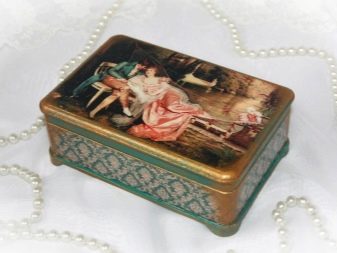
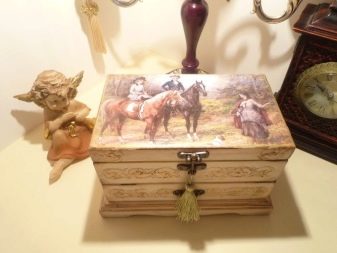
He does not avoid, but, on the contrary, zealously uses shades of gold, green, red. The style does not muffle these colors, but “takes them to the forefront”. Stripes and cages are especially expensive for the Victorian style - such ornaments are embodied in the decor of small accessories and in the design of furniture.
As for the plots, plots with classic English roses, animals (exotic), oak leaves and hunting scenes dominate here. At the same time, the stylization of plots does not strive for simplicity, but, on the contrary, for the elaboration of every detail. I would like to take a large magnifying glass and do what Bosch's paintings offer us - to examine every little thing, every curl and stroke.
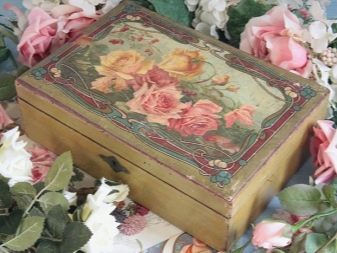
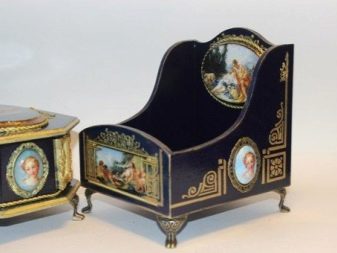
If you intend to fill your interior with products decorated in Victorian style, this is an application for aristocracy.
Ethnic style
Everything is simple here - it is a national style. You can do decoupage in the Japanese style (or in another oriental), in African, Mexican - whatever! The main thing is to remain committed to national motives. And this is a very interesting work, because making things in ethnic style, you are saturated with the history and culture of other countries, becoming more knowledgeable.
Top destinations of this style.
- Japanese. In these motifs, flowers dominate (how to do without sakura), herbs, trees, butterflies, birds. The Japanese, as you know, are careful about the environment. They see the point in things that seem ordinary to us, not particularly significant. And this spirituality of all living things is well transmitted in decoupage. Shades in the Japanese style are dominated by neutral ones - beige, white, cream, milk.
- Indian. This style glorifies the diversity of colors - bright raspberry, orange, blue, turquoise, red-brown. Be sure to note in your decoupage works and unusual geometry of images - often these are circles of different sizes. It is not complete without the addition of gold, silver.
- African. This is probably the greatest exotic among all ethnic styles. The texture is rough, the forms are simple, all colors speak of a hot climate. If you want to make a decorative plate using the African-style decoupage technique, be sure to include the performance of Gumilyov’s poem “Giraffe” - combining art with a common source of inspiration always helps in your work.

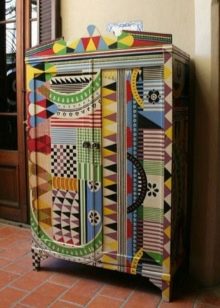
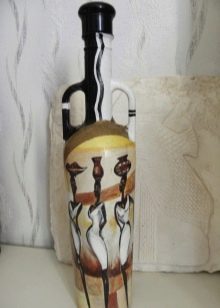
Where to use ethnicity? There are no strict frames. If these are all the same decorative plates, decoupage will serve the kitchen. If you make an elegant box, it will decorate the dressing table in the bedroom.
Steampunk
This is a very interesting modern style, the other name of which is paropunk. It is based on one of the areas of science fiction. It has many branches - there is, for example, Victorian steampunk, there is a diesel punk, etc. Art is closely intertwined with technological progress; aesthetic touches of the loft style are used.
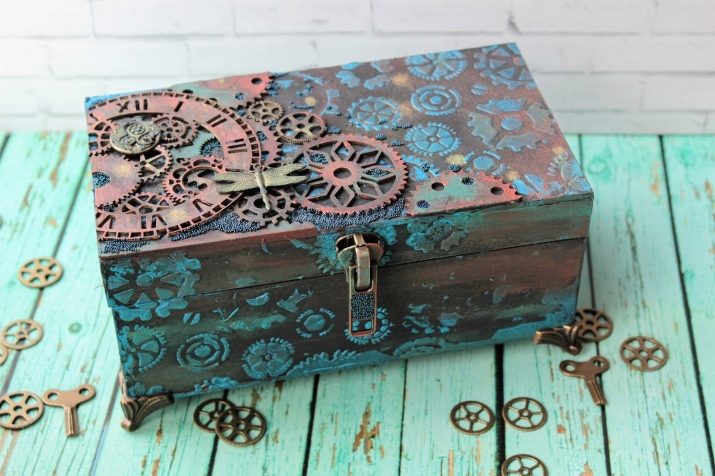
Fans of the style say that this is an interesting allusion to the topic where technological progress would go if there were no electronics and plastic to this day. The style is special, quite complex, although some lovers of decoupage use it in things much simpler - for example, in the decor of Christmas balls. It is very far from loft interiors, but it is also interesting.

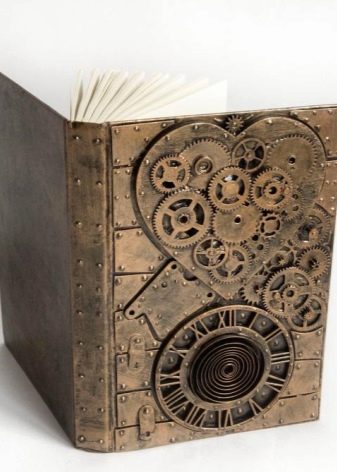
Sea style
You do not need to be an art critic to understand the commandments of the marine style. Blue-white-blue gamut, going into turquoise, lightness, waves, freshness - from works in the marine style blows with a breeze. If you miss the days spent on the coast, why not a piece of your memories and translate into products made using decoupage technique?

Some lovers of sea holidays get beautiful glass jars, pour sand from their favorite beach, shells, pebbles there, and the jar itself is decorated with napkins in a marine theme.
A good and very lively reminder of the sea!
Country
This style is adored by hundreds of thousands of people on the planet. Cozy, understandable, simple, and at the same time voluminous, by no means minimalistic. Someone like the elegance of Baroque, someone prefers to design the space of the house in black and white style, and someone does not have anything nicer than country.
Everything in this style reminds of rural life: not the simplest and the most physically difficult, but filled with daily “zen”, as they would say today in social networks, from unity with nature, fresh air, the exciting aroma of herbs and the proximity of the knowledge of the secrets of the universe.
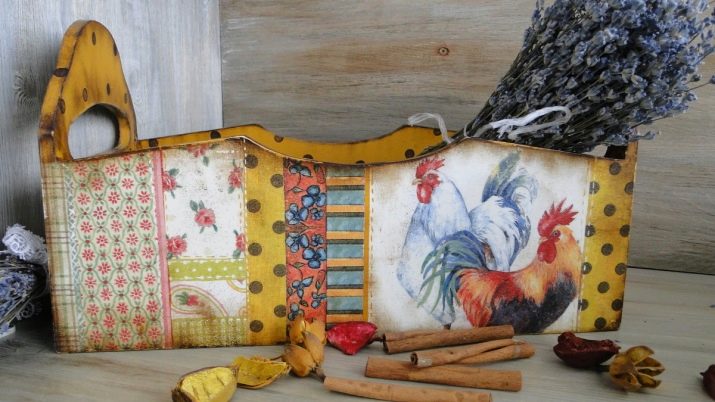
If the pre-revolutionary vintage is not particularly interesting to you, and everything that is urbanistic has got a sore point, it's time to “heal” the country. And even if you live in a city, in your apartment or house there may be a place for everything - including rural motives.
And when the basics of decoupage will be comprehended, you will most likely begin to try combined techniques (for example, decoupage and terra), and you will discover many interesting things. The stylistic knowledge is so good because many already amazing cases of interior transformations began with unpretentious decoupage. One novice craftswoman made a mirror in a Shebby-chic style, and a couple of years later her entire apartment was transformed.
Decor and decoupage in the style of Provence - in the next video.
